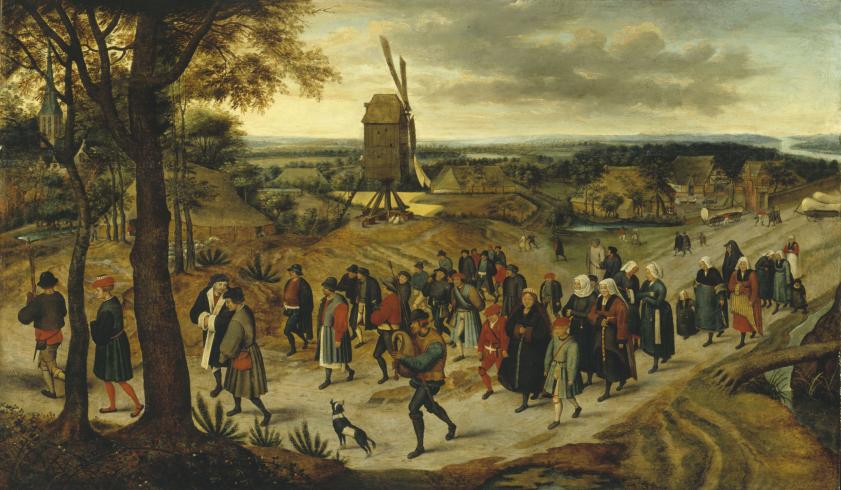A long wedding procession makes its way along the main road of a village, from the centre of the parish, shown on the right of the composition, to the church hidden in the trees, depicted on the left. In accordance with the wedding traditions of 16th and 17th century Flanders, the men move forward separately. The bride and groom each walk at the head of two processions, preceded by a musician playing the bagpipes, the ritual instrument of Flemish weddings and festivals, and are followed by their two fathers and mothers. On the left, the groom, framed by two tree trunks, wears the traditional crown set on a red cap. In the centre of the composition, the bride, wrapped in a thick coat and framed by two young pageboys, also wears a small crown atop her long, loose hair.
The sinuous lines of the procession echo those of the vast undulating landscape which stretches out in the background, dominated by a large windmill overhanging a little knoll. Despite the sunny weather, a storm threatens in the sky, as is common in summer on the plains of Flanders. No men are working in the fields, sacks of grain lean against the feet of the motionless mill, sheep graze peacefully in front of a large, thatched sheepfold: the entire village seems to have stopped in order to celebrate this day, the most important in the life of a peasant. Only a few women, in the farm to the right, are busying themselves preparing the feast in large cooking pots set on wood fires, while covered wagons have arrived, presumably dropping off guests.
The scene was painted for the first time by Pieter Brueghel the Elder, around 1565, in a picture which has since disappeared. In 1623, his youngest son, Jan Brueghel the Elder, produced the first copy of this work, held at the Brussels City Museum. Pieter Breughel the Younger, the master’s eldest son, produced this one, also dating from 1623. The painter, also known as “Hellish” Breughel, even though infernal scenes were an exception in his work, was the head of a highly productive studio and devoted most of his career to reproducing the paintings of his father. In the 17th century, this type of genre scene, depicting with touching realism the everyday life of an affluent peasant class, was very popular both in high society and among the less well-off. This explains the number of replicas of the work, seven of which have now been identified with certainty.
H. D.

City of Paris municipal collection's website
The collections portal can be used to search the collections of Paris’s 14 municipal museums (approximately 336,000 works, including 43,000 belonging to the Petit Palais).
It is also possible to download around 12,000 images of the museum’s works free of charge.
Access the Museums of the City of Paris collections portal
Extern databases
Discover a selection of databases online presenting works from the Petit Palais or documents concerning the history of the museum.

